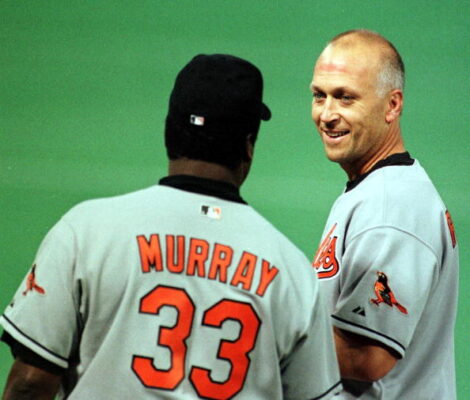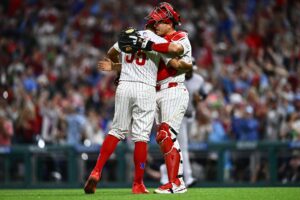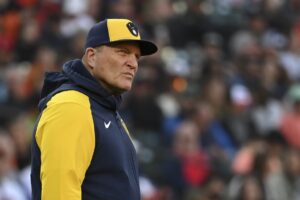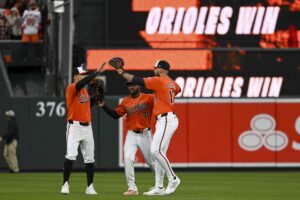Baltimore Orioles All-Time Team
Last Word on Baseball is running a tournament pitting all 30 all-time rosters against each other. Here is the Baltimore Orioles all-time team. The Orioles’ history begins in 1954, when the perennial doormat St. Louis Browns moved east and rebranded. Upon arrival in Baltimore, the Orioles spent the next decade building themselves into a winner. It paid off in 1966, when they won their first pennant en route to stunning the Los Angeles Dodgers in a four-game sweep for the World Series crown. From 1968 to 1983, the Orioles had a remarkable run. They finished second in the American League in 1968, the last year before divisional play. In the 15 seasons from 1969 to 1983, they finished first in the AL East seven times, second six times, third once, and fourth once.
Each all-time team roster has the eight position players, a designated hitter (even the NL teams, for consistency), a starting pitcher, three relievers, and four honorable mentions. For the relievers, starters can be used if a) there aren’t enough elite relievers to fill out the roster or b) if the starters are simply too good to be excluded. Statistics used to determine the spots on the Orioles all-time roster are only from each player’s time as an Oriole (or Brown). WAR was used as a baseline but not as the be-all, end-all statistic. Without further ado, here is the Baltimore Orioles All-Time Team.
Baltimore Orioles All-Time Tournament Team
Manager
This conversation started and ended with Hall of Fame manager Earl Weaver. The Earl of Baltimore was known for his arguments with umpires, his fiery temper, clever quotes to the press, and winning. In his 18 full or partial seasons at the helm (1968–82, 85–86), Weaver had a record of 1480–1060 for a winning percentage of .583. This is the best record of all St. Louis Browns/Baltimore Orioles who managed for at least a full season.
Catcher
Chris Hoiles, who played 10 seasons for the Orioles, backstops this team. He edged out 1983 World Series MVP Rick Dempsey for the spot. Hoiles spent his entire 10-year career (1989–1998) with the Orioles. He slashed .262/.366/.467 (739-for-2820) with 122 doubles, two triples, 151 home runs, 449 RBI, and 415 runs scored in 894 games. This gave him a .368 wOBA and 107.2 wRAA. Defensively, Hoiles was average. His Total Zone Runs Above Average (Rtot) was seven, meaning that the Orioles gave up seven fewer runs by having Hoiles as the catcher instead of the average catcher in the league.
First Base
Switch-hitting Hall of Famer Eddie Murray is the first baseman. In his career, he became the third member of the 3,000 Hit–500 Home Run club, joining Willie Mays and Henry Aaron. As an Oriole, Murray slashed .294/.370/.498 (2080-for-7075) with 363 doubles, 25 triples, 343 home runs, 1224 RBI, and 1084 runs scored in 1884 games. This gave him an Oriole wOBA of .379 and a franchise-high 366.8 wRAA.
Defensively, Murray had an Rtot of 49 while playing first base for the Orioles. He won Gold Gloves three straight seasons, 1982 through 1984.
Second Base
Bobby Grich had some big shoes to fill when he succeeded Davey Johnson as the primary second baseman in 1973. Grich made his debut in 1970 but only played in 37 total games in 1970 and ’71. In 1972, Weaver rotated Grich into the lineup between second base and shortstop, taking playing time from Johnson and defensive wizard Mark Belanger, respectively. In November of 1972, the Orioles traded Johnson to the Atlanta Braves as part of a six-player deal.
There was a reason. Grich was younger, a better defender — which is saying a lot, given that Johnson was a strong defender in his own right — and was a more productive hitter. Across seven seasons, Grich slashed .262/.372/.405 (730-for-2790) with 137 doubles, 27 triples, 70 home runs, 307 RBI, and 432 runs scored. This gave him a .359 wOBA and 106.2 wRAA. This doesn’t tell the whole story, though. In his four years as the primary second baseman, he averaged 22.7 wRAA per season — well ahead of all second basemen in Major League Baseball not named Joe Morgan or Rod Carew. Defensively, he was the best second baseman in the majors during this stretch as well — 55 Rtot, 18 ahead of the runner-up, Rennie Stennett of the Pittsburgh Pirates. No wonder the Orioles were so heartbroken when he signed with the California Angels after the 1976 season.
Shortstop
The obvious answer here is Cal Ripken, Jr., and there is little wonder why. In 21 seasons, the Hall of Famer and 19-time All-Star slashed .276/.340/.447 (3184-for-11551) with 603 doubles, 44 triples, 431 home runs, 1695 RBI, and 1647 runs scored. The 1982 Rookie of the Year never struck out more than 100 times in a season, racking up eight Silver Sluggers, two MVPs, and two All-Star MVPs in the process. His offensive performance translated to a .346 wOBA and 219.3 wRAA.
Ripken was also an excellent defender. His 176 Rtot as a shortstop is the third-highest ever, trailing only Ozzie Smith (239) and fellow Oriole Mark Belanger (238). To put this in perspective, Smith and Belanger are the second- and third-best defenders at any position, coming in behind the next player on the Orioles All-Time team.
Third Base
Hall of Famer Brooks Robinson — nicknamed “The Human Vacuum Cleaner” — was the runaway choice here. Over 23 seasons — all as an Oriole — the 18-time All-Star and 1964 AL MVP slashed .267/.322/.401 (2848-for-10654) with 482 doubles, 68 triples, 268 home runs, 1357 RBI, and 1232 runs scored in 2896 games. He also struck out only 990 times, never more than 84 times in a season. This gave him a .322 wOBA and 88.0 wRAA.
While he was no slouch at the plate, his hitting is not what put him on the list. He has the highest Rtot ever — 293. Yes, by having him playing third instead of the average third baseman in the league, the Orioles gave up 293 fewer runs. To put that in perspective, there are only five players with 200 or more Rtot in their careers — Robinson, Ozzie Smith, Mark Belanger, Andruw Jones (230), and Roberto Clemente (204). As far as third basemen go, Robinson is 125 runs ahead of second-place Adrian Beltre. He also has more than twice as many Rtot as sixth-place Scott Rolen (140). No wonder Robinson had 18 Gold Gloves…in a row, winning his 18th at the age of 38.
Left Field
Now for the first player on the all-time roster who played for the St. Louis Browns — Ken Williams. In 10 seasons (1918–1927), he slashed .326/.403/.558 (1308-for-4015) with 236 doubles, 70 triples, 185 home runs, 811 RBI, 497 walks vs. 240 strikeouts, and 757 runs scored. This gave him a .435 wOBA and 334.8 wRAA. Williams led the American League in home runs and RBI in 1922, smashing 39 and 155, respectively.
Center Field
Paul Blair is our choice for center field. His WAR as an Oriole (39.7) is tops for primary center fielders and 12th in franchise (Browns/Orioles) history. The two-time All-Star spent 13 seasons with the Orioles, slashing .254/.306/.388 (1426-for-5606) with 269 doubles, 51 triples, 126 home runs, 567 RBI, and 737 runs scored. This gives him a .314 wOBA and 17.8 wRAA.
His offense is not why he’s here, however. Paul Blair is number three on the all-time leaderboard for Rtot as a center fielder, with 170 of his 171 coming in an Orioles uniform. He trails only Jones (230) and Willie Mays (176). Blair won eight Gold Gloves — his first in 1967 and seven straight between 1969 and 1975. With Blair in center, Brooks Robinson at third, Ripken at short, and Grich at second, few (if any) all-time rosters can compete with the Orioles defensively.
Right Field
Frank Robinson, the only player in major league history to win MVP in both leagues (1961 NL, 1966 AL), is the first-choice right fielder. In his six years as an Oriole, he slashed .300/.401/.543 (882-for-2941) with 143 doubles, 18 triples, 179 home runs, 545 RBI, 460 walks vs. 452 strikeouts, and 555 runs scored in 827 games. His wOBA as an Oriole was .415, good for 279.1 wRAA. Keep in mind, wRAA is cumulative, and he did this in only six seasons. That makes for an average of 46.5 wRAA per season. His Rtot in right field as an Oriole was -10, but his offensive production was so high that it didn’t matter.
Designated Hitter
George Sisler was one of the greatest baseball players ever to live, and relatively few have heard of him because he played for the St. Louis Browns. Since the Orioles do not acknowledge the Browns as part of their history, he is a “franchise orphan.” When Ichiro broke the single-season hits record in 2004, it was Sisler’s record that he broke — a record that had stood for 84 years. Sisler is one of only two players to ever hit .400 or better in multiple seasons, the other being Ty Cobb. He did not quite make the 3000 Hit Club due to his relatively short career, only 15 years. We put Sisler at DH because he played first base, and the Orioles already have a very good one.
As a Brown, Sisler slashed .344/.384/.481 (2295-for-6667) with 343 doubles, 145 triples, 93 home runs, 962 RBI, 351 stolen bases, 385 walks vs. 278 strikeouts, and 1091 runs scored. This gave him a wOBA of .402 and 356.9 wRAA — second in franchise history and tops from the St. Louis era. Sisler’s career WAR as a Brown (54.7) was the highest in the St. Louis era and has only been surpassed since the move to Baltimore by Ripken, Brooks Robinson, Murray, and the next guy….
Pitching Staff
…Jim Palmer, who is one of the four pitchers on the Orioles All-Time Tournament Team pitching staff. Palmer spent his entire 19-season career with the Orioles (1965–67, 1969–1984) and was voted into the Hall of Fame on the first ballot (1990) with over 90% of the vote. Palmer had a distinguished career, going 268–152 with a 2.86 ERA (79 ERA–). In addition, Palmer had 211 complete games, 53 shutouts, 2212 strikeouts, a 1.180 WHIP, and 3948 innings across 521 starts and 37 relief appearances. Famously, Palmer never game up a grand slam in his major league career. He won 20 or more games in eight separate seasons and is the only person to be on all six Baltimore pennant winners.
Hall of Famer Mike Mussina, although a starter, is one of the three relievers for the Baltimore Orioles All-Time Tournament Team. He was simply too good to leave off the squad. As an Oriole, Mussina went 147–81 with a 3.53 ERA (77 ERA–). He added 1535 strikeouts, a 1.175 WHIP, and 2009 2/3 innings in 288 games, all starts.
Urban Shocker is another starter who will be used as a reliever due to simply being too good for exclusion. He pitched seven seasons for the Browns (1918–1924) after arriving in a trade from the New York Yankees. During his time in St. Louis, he went 126–80 with a 3.19 ERA (78 ERA–). In addition, he had 143 complete games, 23 shutouts, 704 strikeouts, and a 1.239 WHIP in 1749 2/3 innings. The Browns traded him back to the Yankees in December 1924 for Bullet Joe Bush and Milt Gaston.
(Author’s Note: If we were limiting this to Baltimore players only, Dave McNally would replace Urban Shocker.)
Final Relief Spot
This was a tough decision, but we ultimately went with Stu Miller over Hall of Famer Hoyt Wilhelm due to his mastery of clutch late innings. Miller pitched 297 games for the Orioles from 1963–67, all in relief. He was one of the finest stoppers of the era, with a 2.37 ERA (69 ERA–), a 1.120 WHIP, and what would have been 99 saves had they been invented yet. Miller had an extremely low home run rate of 1.3% to go with a 21.4% strikeout percentage and an 8.8% walk percentage, a difference of 12.6 percentage points.
Miller’s prowess in Goose Eggs was so high that Nate Silver mentioned him in the column that introduced the stat. He had 260 Goose Eggs vs. 40 Broken Eggs and 27 Mehs. This gave him a GE:BE ratio of 6.5 to 1, more than twice as high as the historical average ratio of 3:1. Miller was exceptionally brilliant in 1965, when he went 79–7–3 for a ratio of 11.3 to 1, as well as the championship year of 1966, when he was 62–10–3 for a ratio of 6.2 to 1.
Honorable Mentions
If this were Baltimore only, Boog Powell would be the left fielder, since he started his career in left field. But including the Browns has bumped Powell to Honorable Mention. Powell has the second-highest wRAA as an Oriole (295.2), trailing only Murray, who happens to play Powell’s primary position. (Author’s Note: When including the St. Louis Browns, Powell falls to fourth, trailing Sisler and Williams.) Powell was a four-time All-Star, the 1970 AL MVP, and the 1969 runner-up to the fully deserving Harmon Killebrew. The fan favorite spent 14 seasons in a Baltimore uniform between 1961 and 1974. In that span, he slashed .266/.362/.465 (1574-for-5912) with 243 doubles, 11 triples, 303 home runs, 1063 RBI, and 796 runs scored in 1763 games. This gave him a .366 wOBA and 295.2 wRAA.
Bobby Wallace played shortstop for the Browns for 15 seasons (1902–1916). Across 1569 games, he slashed .258/.326/.328 (1424-for-5529) with 236 doubles, 65 triples, eight home runs, 607 RBI, 526 walks vs. 393 strikeouts, and 609 runs scored. We don’t have any hard data to prove it, but anecdotally, he was known as one of the best defenders in league. Due largely to his defensive prowess, he is sixth in franchise history in WAR as a Brown or Oriole and was inducted into the Hall of Fame by the Veterans Committee in 1953.
Harlond Clift is another player from the St. Louis era. He played third base for the Browns from 1934 to 1943, when he was traded to the Washington Senators. Clift slashed .277/.394/.453 (1463-for-5281) for the Browns, with 294 doubles, 62 triples, 170 homers, 769 RBI, 986 walks vs. 649 strikeouts, and 1013 runs scored in 1443 games. His .393 wOBA translated to 278.4 wRAA, sixth highest in franchise history.
An Otherworldly Glove
Mark Belanger is second all-time in Rtot by shortstops with 238 — trailing only Ozzie Smith, who has 239. Belanger put up his numbers in 6000 fewer innings, so some argue that Belanger was actually better than Smith. Either way, Belanger was in a different galaxy than his peers when it came to his glove. His famously anemic hitting is what is keeping him out of the Hall of Fame — his .272 wOBA and -208.3 wRAA are the lowest in franchise history for those with 1000 plate appearances or more. However, he is ninth all-time in WAR by an Oriole or Brown and sixth by an Oriole — his defense was that good.
Honorable Mentions for Baltimore only: Hoyt Wilhelm, Manny Machado, Melvin Mora, Ken Singleton
Batting Order for Baltimore Orioles All-Time Tournament Team
| 1 | Paul Blair (CF) |
| 2 | George Sisler (DH) |
| 3 | Frank Robinson (RF) |
| 4 | Eddie Murray (1B) |
| 5 | Ken Williams (LF) |
| 6 | Cal Ripken (SS) |
| 7 | Brooks Robinson (3B) |
| 8 | Bobby Grich (2B) |
| 9 | Chris Hoiles (C) |
Pitchers: Jim Palmer (Starter), Mike Mussina, Urban Shocker, Stu Miller
Baltimore Only
| 1 | Paul Blair (CF) |
| 2 | Bobby Grich (2B) |
| 3 | Frank Robinson (RF) |
| 4 | Eddie Murray (1B) |
| 5 | Boog Powell (LF) |
| 6 | Cal Ripken (DH) |
| 7 | Brooks Robinson (3B) |
| 8 | Chris Hoiles (C) |
| 9 | Mark Belanger (SS) |
Pitchers: Jim Palmer (Starter), Mike Mussina, Dave McNally, Stu Miller
Looking Ahead
Stay tuned in the coming days for coverage of the all-time tournament, including matchups and the results.
In the meantime, check out the All-Time Team Tournament Headquarters here.
Main Photo:
Players/managers mentioned:
Earl Weaver, Chris Hoiles, Rick Dempsey, Eddie Murray, Willie Mays, Henry Aaron, Bobby Grich, Davey Johnson, Mark Belanger, Joe Morgan, Rod Carew, Rennie Stennett, Cal Ripken, Jr., Ozzie Smith, Brooks Robinson, Andruw Jones, Roberto Clemente, Adrian Beltre, Scott Rolen, Ken Williams, Paul Blair, Frank Robinson, George Sisler, Ty Cobb, Jim Palmer, Mike Mussina, Urban Shocker, Bullet Joe Bush, Milt Gaston, Dave McNally, Boog Powell, Harmon Killebrew, Bobby Wallace, Harlond Clift, Stu Miller, Hoyt Wilhelm, Manny Machado, Melvin Mora, Ken Singleton






